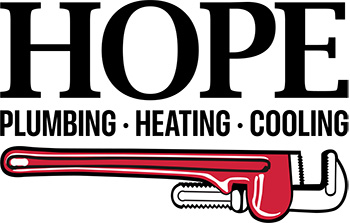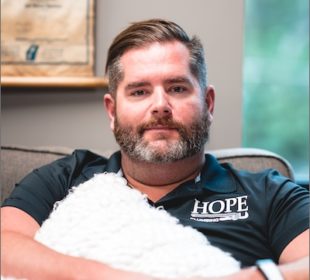As the winter holiday season approaches, homeowners throughout Indianapolis, IN, often begin to make travel plans. If you’ll be away from home for any length of time, you may leave your home in a vulnerable state without being aware of it. Winters bring temperatures well below freezing, which can easily damage your plumbing. You may return to burst pipes and significant water damage. It is essential to learn how to prevent pipe freezing in our climate. Here are some of the tactics we recommend at Hope Plumbing, Heating and Cooling to safeguard your plumbing system this holiday season.
Consider Your Thermostat Settings
When you’re away from home, it’s tempting to lower your thermostat to save money. However, doing so dramatically increases the odds that your pipes will freeze. This is because the air temperature in your home is one of the main things preventing water from freezing in pipes. As a result, you should never lower your home’s thermostat in the winter below 55 degrees Fahrenheit. In fact, you should leave it closer to 65 if you’re going to be away for an extended period. If your heating system malfunctions and fails to turn on, the higher temperature buys you additional time to get home and solve the problem. A higher temperature further reduces the risk of pipes freezing.
Open Under-Sink Cabinets
Your home’s ambient temperature is your best defense against freezing pipes. However, you shouldn’t assume that your heat reaches every part of your plumbing system. If you have cabinetry concealing under-sink plumbing, temperatures inside may be quite low. It’s often up to 20 degrees colder inside closed under-sink cabinets than it is elsewhere in a home. The cold water in your plumbing readily absorbs heat energy from the air. If there’s no source of warm air to replace that heat energy, temperatures plummet.
To equalize temperatures underneath your sinks, keep the under-sink cabinet doors open. It’s a good idea to open these doors any time you expect outdoor temperatures to fall to freezing or below. It’s especially beneficial if the forecast predicts multiple consecutive days of cold temperatures. Leaving those doors open will benefit your whole plumbing system. It provides critical warmth to the water in your pipes, which spreads throughout your plumbing.
Leave a Faucet Dripping
If your holiday plans include an extended absence from your home, there’s one crucial thing you can do to protect your home before you go. It’s to turn on a faucet in your house just enough to allow a slow drip. Ideally, you should choose a faucet that’s as far away from your incoming water supply line as possible. You achieve protection by allowing water to keep moving through your plumbing system. Moving water takes slightly longer to freeze than still water. This also provides you with a method of relieving pressure in your pipes. If any part of your plumbing freezes despite your best efforts, the extra pressure created by the ice has somewhere to go. This can dramatically reduce the odds that a pipe will burst and cause extensive damage.
Sealing Up Your Home
Keeping cold air out of your home is essential to your comfort. However, it’s even more critical if you want to keep your pipes from freezing. Install weatherstripping around your windows and exterior doors to keep drafts out. You should also use caulk or expanding spray foam to seal any gaps or cracks you find in your exterior walls or on your foundation. Much of your home’s plumbing system runs within exterior walls. Any cold air reaching these areas can impact your plumbing system even if your home feels comfortable.
Winterize Your Hose Bibs
If your home has outdoor hose bibs, they’re more likely to experience freezing than any other part of your plumbing system. This can lead to frozen and burst pipes inside your home as well. It’s necessary to winterize your hose bibs in the fall. To do so, you must first locate the indoor shutoff valve that controls the water supply for each bib. After turning those off, open the hose bib valves to let water drain out fully. You can install insulated hose bib covers for added protection.
Install Pipe Insulation
One of the most effective ways to prevent your pipes from freezing is to insulate them. It’s wise to focus on pipes running through unheated parts of your home. When you insulate pipes in unheated spaces, you prevent cold air from reaching the pipes. The other is that you help keep the heat energy absorbed by bare pipes inside your home from escaping. This can help extend a measure of protection to your entire plumbing system.
Installing pipe insulation is very easy when you’re dealing with easily accessible pipes. Pipe insulation kits typically consist of foam tubes with a split edge. This makes it possible for a plumber to slip the foam insulation over the pipe they’re working on with minimal effort. Then, the insulation can be trimmed to an appropriate length as necessary. Once the insulation fits properly, sealing the split edge using a built-in adhesive strip completes the process. The flexibility of foam insulation even makes negotiating bends and direction changes in your pipes a breeze.
If you’re interested in pipe insulation, you can schedule a consultation with one of our plumbers. We can assess your pipes and let you know which parts of your plumbing remain vulnerable to freezing. You can use this information as the basis of an insulation project plan.
Consider Garage Insulation
One of the parts of the average home that often leaves pipes vulnerable to freezing is its garage. Few garages have sufficient insulation, since this isn’t a space that is usually part of a home’s useful living space. If your garage has pipes running through it, this poses a problem. Even if plumbing doesn’t run through your garage, this is a common entry point for cold air that can threaten pipes elsewhere. Adding insulation to your garage door is a great way to start correcting this problem. You can even add insulation to your garage walls for additional support. Doing so will also make the space more comfortable throughout the year if you want to use this area for things like storage or hobbies.
Consider Installing Heat Tape
Consider having heat tape installed on your exposed pipes. Heat tape is a form of electric resistance heating meant to safeguard pipes during freezing weather. It wraps around uninsulated pipes in unheated spaces, where it automatically warms your pipes when needed. Heat tape kits include a controller that plugs right into a standard outlet. That makes it easy to install in almost any situation. However, if you opt for heat tape, don’t neglect the previous strategies. It’s best to use it only as part of a layered defense against frozen pipes.
Your Local Plumbing Team
Hope Plumbing, Heating and Cooling is your go-to provider of plumbing services in Indianapolis. We specialize in aging plumbing systems. Our team of expert plumbers can help you defend your home’s plumbing from the cold. We also offer comprehensive plumbing repair services for when pipes or fixtures fail.
We are licensed, bonded, and insured for your peace of mind. If you need quality plumbing services, call Hope Plumbing, Heating and Cooling today.


